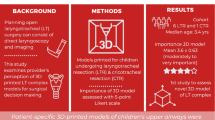Abstract
Purpose
The aim of this study was to compare the force exerted by a three-dimensional (3D) printed modified supraglottic airway (mSGA) vs. that exerted by the i-gel on a 3D printed airway model.
Methods
After a preliminary experiment in Thiel embalmed cadavers, we created a 3D printed mSGA and five 3D printed airway models based on computed tomography data from five female Japanese patients. We compared the force exerted by the i-gel and mSGA on the larynx of the 3D printed airway models. In addition, tidal volumes with insertion of the airway devices into the 3D printed airway model and administration of different levels of pressure-controlled ventilation (PCV) were compared.
Results
The values below indicate mean values ± SD (p value, 95% confidence interval) for the mSGA and i-gel, respectively. The forces exerted by the cuff parts were as follows: ventral: 12.5 ± 5.4 vs. 20.7 ± 3.7 N (p = 0.0001, − 10.0 to − 6.5), proximal: 1.9 ± 1.4 vs. 1.7 ± 1.3 N (p = 0.322, − 0.26 to 0.74), and dorsal parts: 6.9 ± 2.2 vs. 12.5 ± 4.8 N (p = 0.0001, − 7.9 to − 3.4), respectively. We also found significantly higher tidal volumes with the mSGA under PCV of 10, 15, and 20 cmH2O.
Conclusions
The method of creating the mSGA that we proposed in this study can be applied to development of novel SGAs that is anatomically more suitable for pharyngolaryngeal structure.






Similar content being viewed by others
References
Niforopoulou P, Pantazopoulos I, Demestiha T, Koudouna E, Xanthos T. Video-laryngoscope in the adult airway management: a topical review of the literature. Acta Anaesthesiol Scand. 2010;54(9):1050–61.
de Boer HD, Driessen JJ, Marcus MA, Kerkkamp H, Heeringa M, Klimek M. Reversal of rocuronium-induced (1.2 mg/kg) profound neuromuscular block by sugammadex: a multicenter, dose-finding and safety study. Anesthesiology. 2007;107(2):239–44.
Apfelbaum JL, Hagberg CA, Caplan RA, Blitt CD, Connis RT, Nickinovich DG, Hagberg CA, Caplan RA, Benumof JL, Berry FA, Blitt CD, Bode RH, Cheney FW, Connis RT, Guidry OF, Nickinovich DG, Ovassapian A, American Society of Anesthesiologists Task Force on Management of the Difficult Airway. Practice guidelines for management of the difficult airway: an updated report by the American Society of Anesthesiologists Task Force on Management of the Difficult Airway. Anesthesiology. 2013;118(2):251–70.
Japanese Society of Anesthesiologists. JSA airway management guideline 2014: to improve the safety of induction of anesthesia. J Anesth. 2014;28(4):482–93.
Frerk C, Mitchell VS, McNarry AF, Mendonca C, Bhagrath R, Patel A, O’Sullivan EP, Woodall NM, Ahmad I, Difficult Airway Society intubation guidelines working group. Difficult Airway Society 2015 guidelines for management of unanticipated difficult intubation in adults. Br J Anaesth. 2015;115(6):827–48.
Häske D, Schempf B, Gaier G, Niederberger C. Performance of the i-gel™ during pre-hospital cardiopulmonary resuscitation. Resuscitation. 2013;84(9):1229–32.
Berlac P, Hyldmo PK, Kongstad P, Kurola J, Nakstad AR, Sandberg M, Scandinavian Society for Anesthesiology and Intensive Care Medicine. Pre-hospital airway management: guidelines from a task force from the Scandinavian Society for Anaesthesiology and Intensive Care Medicine. Acta Anaesthesiol Scand. 2008;52(7):897–907.
Saito T, Liu W, Chew ST, Ti LK. Incidence of and risk factors for difficult ventilation via a supraglottic airway device in a population of 14,480 patients from South-East Asia. Anaesthesia. 2015;70(9):1079–83.
Ramachandran SK, Mathis MR, Tremper KK, Shanks AM, Kheterpal S. Predictors and clinical outcomes from failed Laryngeal Mask Airway Unique™: a study of 15,795 patients. Anesthesiology. 2012;116(6):1217–26.
Eschertzhuber S, Brimacombe J, Kaufmann M, Keller C, Tiefenthaler W. Directly measured mucosal pressures produced by the i-gel™ and Laryngeal Mask Airway Supreme™ in paralysed anaesthetised patients. Anaesthesia. 2012;67(4):407–10.
Kimijima T, Edanaga M, Yamakage M. Laryngeal mucosal pressure exerted by i-gel™: an experimental study in Japanese human cadavers. Anesthesiology A1132. 2016;67:407–10
i-gel. User Poster—adult sizes. http://www.intersurgical.co.uk/products/airway-management/i-gel-supraglottic-airway#downloads.
Brenner E. Human body preservation—old and new techniques. J Anat. 2014;224(3):316–44.
Russo SG, Cremer S, Eich C, Jipp M, Cohnen J, Strack M, Quintel M, Mohr A. Magnetic resonance imaging study of the in vivo position of the extraglottic airway devices i-gel™ and LMA-Supreme™ in anaesthetized human volunteers. Br J Anaesth. 2012;109(6):996–1004.
Brimacombe J, Keller C. A comparison of pharyngeal mucosal pressure and airway sealing pressure with the laryngeal mask airway in anesthetized adult patients. Anesth Analg. 1998;87(6):1379–82.
Keller C, Brimacombe J. Pharyngeal mucosal pressures, airway sealing pressures, and fiberoptic position with the intubating versus the standard laryngeal mask airway. Anesthesiology. 1999;90(4):1001–6.
Ulrich-Pur H, Hrska F, Krafft P, Friehs H, Wulkersdorfer B, Kostler WJ, Rabitsch W, Staudinger T, Schuster E, Frass M. Comparison of mucosal pressures induced by cuffs of different airway devices. Anesthesiology. 2006;104(5):933–8.
Keller C, Brimacombe J, Moriggl B, Lirk P, von Goedecke A. In cadavers, directly measured mucosal pressures are similar for the Unique and the Soft Seal laryngeal mask airway devices. Can J Anaesth. 2004;51(8):834–7.
Keller C, Brimacombe J. Influence of neuromuscular block, mode of ventilation and respiratory cycle on pharyngeal mucosal pressures with the laryngeal mask airway. Br J Anaesth. 1999;83(3):480–2.
Keller C, Brimacombe J. Mucosal pressures from the cuffed oropharyngeal airway vs the laryngeal mask airway. Br J Anaesth. 1999;82(6):922–4.
Jackson KM, Cook TM. Evaluation of four airway training manikins as patient simulators for the insertion of eight types of supraglottic airway devices. Anaesthesia. 2007;62(4):388–93.
Acknowledgements
We thank Prof. Mineko Fujimiya and the staff of the Department of Anatomy, Sapporo Medical University, School of Medicine for their management of the Thiel embalmed cadavers and for their cooperation in our preliminary cadaver experiments. This work was supported by the Japan Society for the Promotion of Science (JSPS) KAKENHI Grant number 16K20107.
Author information
Authors and Affiliations
Corresponding author
Ethics declarations
Conflict of interest
The authors declare that they have no competing interests.
About this article
Cite this article
Kimijima, T., Edanaga, M. & Yamakage, M. Superior sealing effect of a three-dimensional printed modified supraglottic airway compared with the i-gel in a three-dimensional printed airway model. J Anesth 32, 655–662 (2018). https://doi.org/10.1007/s00540-018-2531-7
Received:
Accepted:
Published:
Issue Date:
DOI: https://doi.org/10.1007/s00540-018-2531-7




